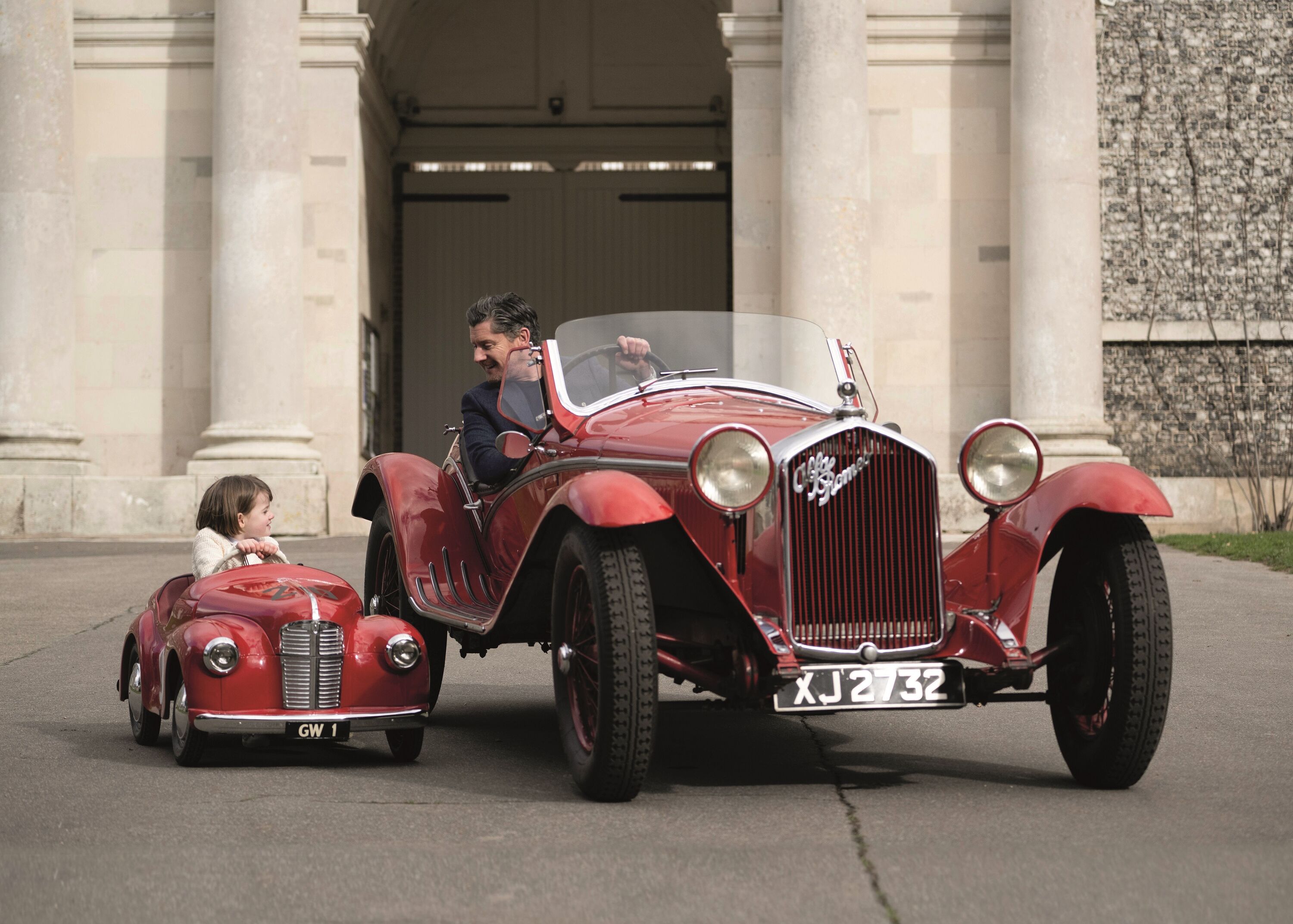Doug Nye – Those '50s heroes
 Doug Nye
Doug Nye
Footage is presently being shot for a major documentary movie on the lost generation of frontline racing drivers during the 1950s. Almost coincidentally they each drove for Ferrari – the two British aces Mike Hawthorn and Peter Collins, the Italian rivals Luigi Musso and Eugenio Castellotti, and the aristocratic Spanish Marquis ‘Fon’ de Portago.

Four of the five actually lost their lives behind the wheel of a factory Ferrari – Peter Collins while chasing Tony Brooks’s fleeting Vanwall during the 1958 German Grand Prix – Luigi Musso while chasing team-mate Hawthorn desperately hard, on the outermost limit of his and his car’s abilities, during the 1958 French GP – Eugenio Castellotti while testing a Formula 1 Lancia-Ferrari V8 at the Modena Aerautodromo early in 1957 – and poor de Portago following a tyre burst at very high speed in his sports Ferrari while running agonizingly close to the finish of the 1957 Mille Miglia, 1,000-mile round-Italy race.
That was a brutally uncompromising period. The later 1950s generation of frontline racing cars had tremendous performance potential. Their drivers rattled around unrestrained within capacious cockpits, and contemporary thinking amongst the driver group was that it was – self-evidently – better to be thrown out of a crashing car than to be trapped inside it, to be crushed if it rolled over, or burned if it should catch fire.

Mike Hawthorn’s wheel-waving works Ferrari Dino 246 on its winning way - 1958 Easter Monday Goodwood Glover Trophy race
Indeed it was not until 1967-68 that Dr Michael Henderson’s racing in safety campaign finally persuaded most motorsport people statistically that the “better to be thrown clear” notion was complete nonsense, and that the majority of drivers thrown from a crashing car suffered far worse injuries than those restrained by seat belts, as in American speedway racing. Doc Henderson was also instrumental in highlighting the near uselessness of contemporary single-layer cotton racing overalls as fire protection – and it was he who convinced the likes most notably of Jackie Stewart that multi-layer Nomex overalls, gloves, socks and boots, combined with restraint harnesses and realistically protective crash helmets would be A Good Idea…
But none of those boys back in the later 1950s had benefit of such thinking. Indeed one can picture each of them listening open-mouthed to any such suggestions and dismissing them out of hand – “What do you think I am? Some kind of pansy?”. Remember that in 1957-58 the wearing of hard crash helmets in European-style road racing had only been mandatory for five or six years. So what chance would the seat-belt or multi-layer overall salesman stand? He would find himself in much the same situation as the freezer salesman at an Eskimo settlement…

Ferrari works team driver Luigi Musso
Here’s another modern concern those great drivers from the 1950s would find barely credible. As a group of decidedly macho young men they were unconcernedly sexist, racist, almost every “ist” that is so vilified today by the concerned classes. They were hyper-competitive, in every area of their lives, they were (demonstrably) committed, courageous, fearless (or reckless, unimaginative, and dim). Through their own talents, competitiveness and achievements they had clawed their way to the forefront of the select group of frontline international racing drivers who featured weekend in, weekend out, at the sharp end of motor races run worldwide. And ultimately they pushed so hard, or had the simple misfortune, to run out of luck…
The one exception to the “died in action” fate of these great drivers is of course Mike Hawthorn. On October 19, 1958 he became the first Briton to win the FIA’s Formula 1 Drivers’ World Championship title. And just three months later, on January 22,1959, he died in his Jaguar saloon car, wrapped around a small tree beside the A3 Guildford Bypass road in Surrey.

Peter Collins winning the 1958 BRDC International Trophy race at Silverstone in his works Ferrari Dino 246
His climb to motor racing stardom had been achieved largely at Goodwood at which he drove in some 18 races (only) from 1951-58. His most famous exploit there was winning two races and finishing second in another on Easter Monday 1952 – apparently emerging from nowhere in Bob Chase’s brand-new and still unpainted 2-litre Formula 2 Cooper-Bristol. Once established he drove Ferrari Formula and sports cars at Goodwood, plus Tony Vandervell’s highly-modified, Ferrari-based ‘ThinWall Special’, the works BRM Type 25 – which tossed him out as it somersaulted off-track at Madgwick Corner in 1956 – and a Lotus 11. And way back in 1951, with his metaphorical racing L-plates attached, he had made his Goodwood debut in the family Riley Imp and Riley Sprite pre-war sports cars, and won the motor circuit’s ‘Motor Sport’ Brooklands Memorial Trophy competition – with three wins, a 2nd, 3rd and 4th places to his credit.
His great mate Peter Collins had made his Goodwood debut earlier, winning at the 1949 September Meeting in his 500cc Cooper. His full career before his untimely death at the Nürburgring in 1958, included some 15 Goodwood races – in air-cooled Cooper, Aston Martin DB3 and DB3S, Vandervell’s ‘ThinWall Special’ Ferrari, and Vanwall Special, a BRM V16 Mark II, and works Ferrari Dino 196 sports.

Eugenio Castellotti in the experimental streamlined Lancia-Ferrari D50A, 1956 French Grand Prix practice, Reims
The Ferrari boys’ finest day at Goodwood was Easter Monday, 1958, at the outset of their fateful, and fatal, final season. That year was, in effect, the beginning of a fresh Formula 1. Sweeping regulation changes had just been applied which slashed World Championship-qualifying Grand Prix distance from 500km to 300km, or duration from three hours to only two. And alcohol-based racing fuel brews had been banned, and replaced by a requirement to run on AvGas aviation gasoline instead. At a stroke these changes allowed Grand Prix cars to shrink in physical size, around smaller, lower-capacity fuel tanks. Ferrari was best prepared – rarin’ to go with their latest Dino 246 V6-engined cars derived from the 1957 petrol-burning Dino 156 Formula 2 design.
For Easter Monday Goodwood the Italian factory team brought one V6 Formula 1 car for Mike Hawthorn to drive in the Glover Trophy feature race, and the beautifully-proportioned 2-litre Dino 196S V6 sports-racing car for Peter Collins in the supporting Sussex Trophy. Mike promptly won the F1 race – while Collins finished second in the sports car, more than half-a-minute behind Stirling Moss’s winning works Aston Martin DBR2 with its big 3.7-litre engine.
In fact that early season of Formula racing saw Ferrari trousering the money from an impressively unbroken trio of race wins; six days after Goodwood, Luigi Musso won the Syracuse GP in Sicily, and into May Peter Collins’ Dino 246 won the BRDC International Trophy at Silverstone.

Back at Silverstone in July Peter Collins and Mike Hawthorn memorably finished 1-2 for Ferrari in the Championship-qualifying British Grand Prix – two weeks after team-mate Musso had been killed in the French GP, and two weeks before Collins’ tragic death at the Nurburgring.
It really was a rugged and unforgiving era. In retrospect it was also an immensely poignant era. It embodies a story worth telling in this much more cushioned and complacent racing age... and it is one that the movie world is presently addressing.
Photography courtesy of The GP Library.
Doug Nye
F1
Stirling Moss
Mike Hawthorn






